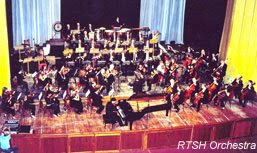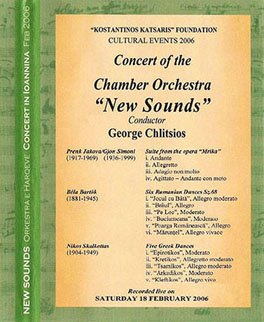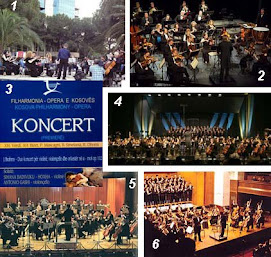.jpg) A book written by June Emerson in 1994. She is the first western musician to have studied the evolution of Albanian music. Her book is the fruit of much travel in Albania and many meetings with performers, composers. She is founder of Emerson Edition and Albanian Musicians Trust in UK. I had a pleasure to meet her in Tirana on 2002 and to have her support in several my projects.
A book written by June Emerson in 1994. She is the first western musician to have studied the evolution of Albanian music. Her book is the fruit of much travel in Albania and many meetings with performers, composers. She is founder of Emerson Edition and Albanian Musicians Trust in UK. I had a pleasure to meet her in Tirana on 2002 and to have her support in several my projects.Monday, September 22, 2008
.jpg) A book written by June Emerson in 1994. She is the first western musician to have studied the evolution of Albanian music. Her book is the fruit of much travel in Albania and many meetings with performers, composers. She is founder of Emerson Edition and Albanian Musicians Trust in UK. I had a pleasure to meet her in Tirana on 2002 and to have her support in several my projects.
A book written by June Emerson in 1994. She is the first western musician to have studied the evolution of Albanian music. Her book is the fruit of much travel in Albania and many meetings with performers, composers. She is founder of Emerson Edition and Albanian Musicians Trust in UK. I had a pleasure to meet her in Tirana on 2002 and to have her support in several my projects.Tuesday, June 24, 2008
Chapter 1: Music in Albania
The urban art songs of 1930s can be considered the initial phase and a major part of Albanian classic music heritage . Urban song in the early 20th century could be divided into two styles: patriotic and the lyrical style. The lyrical style included a wide array of lullabies and other forms, as well as love songs. By the end of the 1930s, urban art songs had been incorporated into classical music, while the first recordings, however, of urban art song came as early as 1937, with the orchestral sounds of Tefta Tashko-Koço. A pivotal composer in modern Albanian classical music was Martin Gjoka, who composed several vocal and instrumental music which uses elements of urban art song and the folk melodies of the northern highlands. Gjoka's work in the early 1920s marks the beginning of professional Albanian classical music. Preng Jakova became well-known for operas like Scanderbeg and Mrika, which were influenced by traditional Italian opera, the belcanto style and Albanian folk song. Undoubtedly the most famous Albanian composer was Çesk Zadeja, known as the Father of Albanian classical music; he composed in many styles, from symphonies to ballets, beginning in 1956 with the Symphony Nr.1.
RTSH Symphonic Orchestra is the most prominent and important ensemble in Albania. It has 60 musicians and a season of 25 concerts with a wide range of styles from classic to pop and modern performances, many of them TV broadcasted and recorded as well. The orchestra has toured Europe and mostly Balkan area. The National Opera Theatre was created in 1957 and its orchestra is active even in the symphonic performances apart for the regular activity with the opera repertory. Both orchestras are formed totally by musicians educated in the Arts Academy of Tirana.
The establishment of chamber music ensembles and groups started at the beggining of '90s. Only few of them have been able to maintain a regular activity and the most persistent is “ New Sounds” string orchestra. It was founded in 2000 as part of a program supported by Swiss Foundation Pro Helvetia in Tirana. This ensemble has played a very significant role developing a modern style of musical performance, collaborating with renowned international artists, invited by many European Festivals in Sarajevo, Belgrade, Greece, etc. Its frequent conductors are George Chlitsios (GR), Malcolm Layfield, director of Goldberg Ensemble and Head of Strings at RNCM Manchester UK, Simon Camartin - Switzerland.
RTSH Symphonic Orchestra is the most prominent and important ensemble in Albania. It has 60 musicians and a season of 25 concerts with a wide range of styles from classic to pop and modern performances, many of them TV broadcasted and recorded as well. The orchestra has toured Europe and mostly Balkan area. The National Opera Theatre was created in 1957 and its orchestra is active even in the symphonic performances apart for the regular activity with the opera repertory. Both orchestras are formed totally by musicians educated in the Arts Academy of Tirana.
The establishment of chamber music ensembles and groups started at the beggining of '90s. Only few of them have been able to maintain a regular activity and the most persistent is “ New Sounds” string orchestra. It was founded in 2000 as part of a program supported by Swiss Foundation Pro Helvetia in Tirana. This ensemble has played a very significant role developing a modern style of musical performance, collaborating with renowned international artists, invited by many European Festivals in Sarajevo, Belgrade, Greece, etc. Its frequent conductors are George Chlitsios (GR), Malcolm Layfield, director of Goldberg Ensemble and Head of Strings at RNCM Manchester UK, Simon Camartin - Switzerland.
Tuesday, May 20, 2008
From: Drew McManus
Date: Tue, 6 May 2008, From: drewmcmanus@comcast.net
Thank you for the note and the update on your new blog. I do check in from time to time and it's looking good - you have quite a bit of regular content and the page is easy to navigate. Keep up the great work.
Drew McManus
Author of 'Adaptistration': a weblog on orchestra management.
http://www.adaptistration.com/ http://www.insidethearts.com/ http://www.orchestraconsulting.com/
Thank you for the note and the update on your new blog. I do check in from time to time and it's looking good - you have quite a bit of regular content and the page is easy to navigate. Keep up the great work.
Drew McManus
Author of 'Adaptistration': a weblog on orchestra management.
http://www.adaptistration.com/ http://www.insidethearts.com/ http://www.orchestraconsulting.com/
Sunday, April 6, 2008
Music of Southeastern Europe – Balkans
Historic view
The music of Southeastern Europe or the Balkans is musically distinctive from the rest of Europe. This is because of the influence of traditional music from Southeastern European ethnic groups and music influences from Byzantine and latter Ottoman Empire periods.
Byzantine traditional music was associated with the medieval sacred chant of Christian Churches following the Constantinopolitan rite. The development of large scale hymnographic forms begins in the 5th century with the rise of the kontakion, a long and elaborate metrical sermon, which finds its acme in the work of St. Romanos the Melodos (6th century). Medieval musical instruments included horns, trumpets, lutes, psalteries, drums and cymbals.
The music of Southeastern Europe or the Balkans is musically distinctive from the rest of Europe. This is because of the influence of traditional music from Southeastern European ethnic groups and music influences from Byzantine and latter Ottoman Empire periods.
Byzantine traditional music was associated with the medieval sacred chant of Christian Churches following the Constantinopolitan rite. The development of large scale hymnographic forms begins in the 5th century with the rise of the kontakion, a long and elaborate metrical sermon, which finds its acme in the work of St. Romanos the Melodos (6th century). Medieval musical instruments included horns, trumpets, lutes, psalteries, drums and cymbals.
"Balkan" is a Turkish word which means sharp mountains.
Many musical instruments were introduced to the Balkans during the time of Ottoman control, but many Ottoman instruments were borrowed from the locals. The influence of Turkish rhythms can also be seen in Balkan Music. In the 19th century, imitations of the Turkish military bands replaced dethroned the ancient traditional oboe (zurna, zurla, or mizmar) and double-headed drum ensembles. Today these ensembles, formerly imported from Turkey are dying out, in part because of modernity, but also because of the growing Balkan nationalism.
Many musical instruments were introduced to the Balkans during the time of Ottoman control, but many Ottoman instruments were borrowed from the locals. The influence of Turkish rhythms can also be seen in Balkan Music. In the 19th century, imitations of the Turkish military bands replaced dethroned the ancient traditional oboe (zurna, zurla, or mizmar) and double-headed drum ensembles. Today these ensembles, formerly imported from Turkey are dying out, in part because of modernity, but also because of the growing Balkan nationalism.
The presence of classical music in Balkans starts in the late 19th, a development tied to the fall of the Ottoman empire. At this time, many Balkan countries established their first musical societies and professional ensembles.............will continue
Saturday, April 5, 2008
From: David Meerman Scott
This looks like a great blog. I hope that it helps you. Don't get discouraged - keep writing.
Best
Best
David Meerman Scott
http://www.webinknow.com/
______________________
"The New Rules of Marketing and PR: How to use news releases, blogs, podcasts, viral marketing and online media to reach your buyers directly" http://www.amazon.com/exec/obidos/ASIN/0470113456/freshspotpubl-20
______________________
"The New Rules of Marketing and PR: How to use news releases, blogs, podcasts, viral marketing and online media to reach your buyers directly" http://www.amazon.com/exec/obidos/ASIN/0470113456/freshspotpubl-20
Thursday, April 3, 2008
Mobility in the Balkans
The possibilities for free and multi-directional mobility of intellectual capital, that is, the drain of creative capital, is a crucial issue of development in every society at the beginning of the third millennium, especially for small states!
The "spiritus movens" of contemporary social progress is no longer the economy of production and trade, but the economy of ideas and creativity. The keys that open the door to this new economy are education, culture, and science!
The most dramatic problem in the Western Balkans (Croatia, Bosnia and Herzegovina, Serbia and Montenegro, Macedonia, and Albania) is a large-scale outflow of intellectual capital, which is the best social resource that the region has at its disposal today.
ONE-WAY TICKET .
The "spiritus movens" of contemporary social progress is no longer the economy of production and trade, but the economy of ideas and creativity. The keys that open the door to this new economy are education, culture, and science!
The most dramatic problem in the Western Balkans (Croatia, Bosnia and Herzegovina, Serbia and Montenegro, Macedonia, and Albania) is a large-scale outflow of intellectual capital, which is the best social resource that the region has at its disposal today.
ONE-WAY TICKET .
The Brain Drain and Trans-border Mobility in the Arts and Culture of the Western Balkans. By Dimitrije Vujadinovic, Balkankult Foundation
This case study was commissioned by the ERICarts Institute in 2006 for their study, MEAC I: Dynamics, Causes and Consequences of Transborder Mobility in the European Arts and Culture, undertaken for the LabforCulture, an initiative of the European Cultural Foundation.
.....................................................................................................
The beginning of '90 brought political system changes in Albania, followed by social changes. Many people, including musicians went abroad. The staff of the symphonic orchestra and the opera house had been completely changed by the end of 1991.....
...All the semiprofessional orchestras in other cities were closed during that time due to the financial difficulties of that period. These organic losses to the profession were pursued by a lack of interest from young people to study music at art schools and subsequently different classes of music instruments were closed for years....
....The state withdrawal from supporting artistic events was partly substituted by other institutions such as foreign foundations, but their funding was mainly addressed to short-term initiatives and a limited number of partners and actually the support to the arts sector and especially to serious music is quite inconsiderable in relation to the necessities of that sector.....(Qazim Kallushi)
Full article at: http://www.ericarts.org/web/files/181/en/Case_Studies_on_Mobility.pdf
The interviews were made with: Sreten Krstic, musician – concert master of the Munich Philharmonic, permanently residing in Munich; Vladimir Gurbaj, student of postgraduate studies in Salzburg and Berlin, lecturer at the School of Music in Salzburg, permanently residing in Sazlburg; Qazim Kallushi, artistic manager from Tirana; Ana Lebedinski, member of the Munich Philharmonic, permanently residing in Munich; Smiljka Isakovic, harpsichord player from Belgrade.
.....................................................................................................
The beginning of '90 brought political system changes in Albania, followed by social changes. Many people, including musicians went abroad. The staff of the symphonic orchestra and the opera house had been completely changed by the end of 1991.....
...All the semiprofessional orchestras in other cities were closed during that time due to the financial difficulties of that period. These organic losses to the profession were pursued by a lack of interest from young people to study music at art schools and subsequently different classes of music instruments were closed for years....
....The state withdrawal from supporting artistic events was partly substituted by other institutions such as foreign foundations, but their funding was mainly addressed to short-term initiatives and a limited number of partners and actually the support to the arts sector and especially to serious music is quite inconsiderable in relation to the necessities of that sector.....(Qazim Kallushi)
Full article at: http://www.ericarts.org/web/files/181/en/Case_Studies_on_Mobility.pdf
The interviews were made with: Sreten Krstic, musician – concert master of the Munich Philharmonic, permanently residing in Munich; Vladimir Gurbaj, student of postgraduate studies in Salzburg and Berlin, lecturer at the School of Music in Salzburg, permanently residing in Sazlburg; Qazim Kallushi, artistic manager from Tirana; Ana Lebedinski, member of the Munich Philharmonic, permanently residing in Munich; Smiljka Isakovic, harpsichord player from Belgrade.
Subscribe to:
Posts (Atom)






